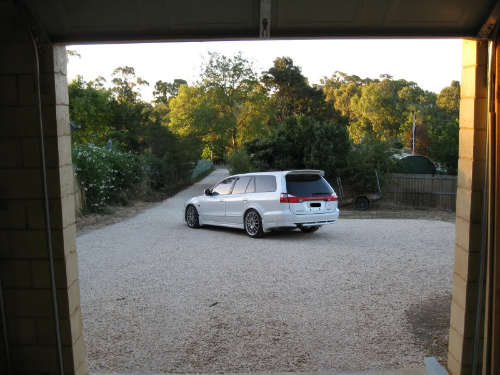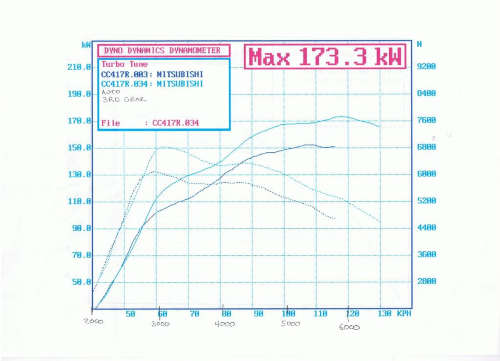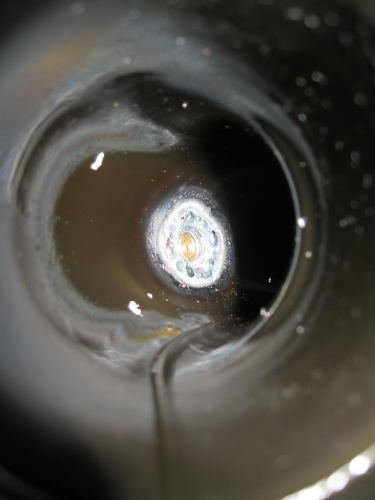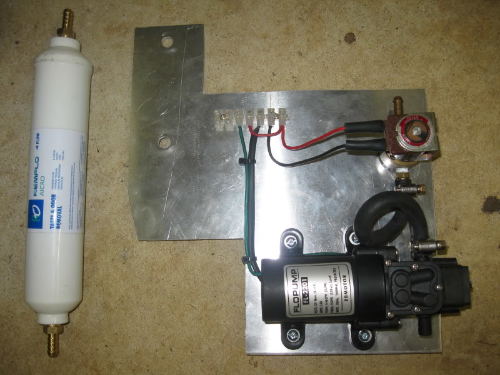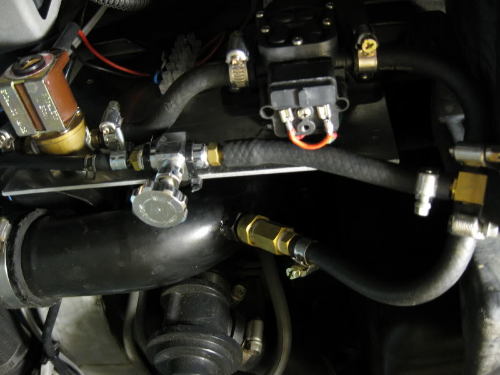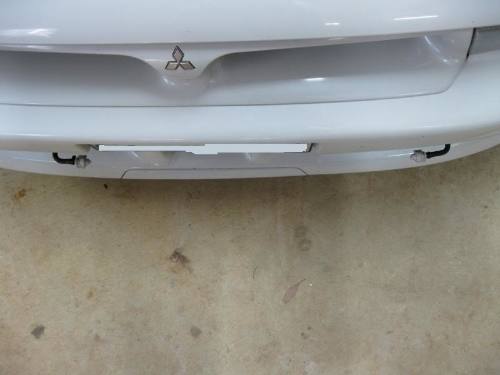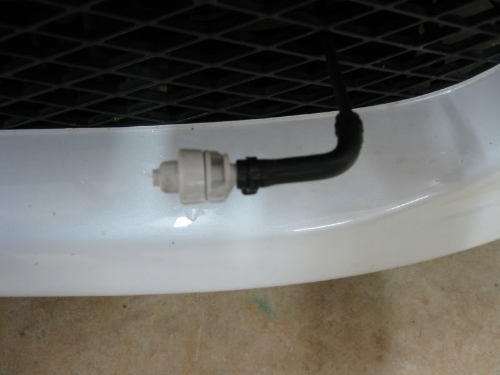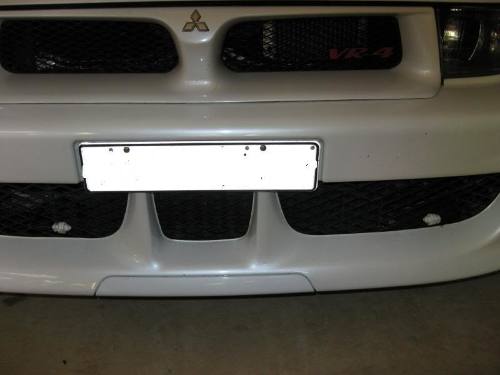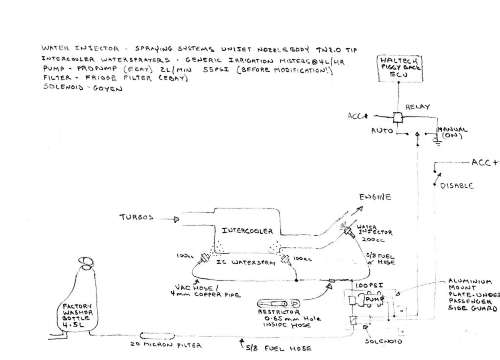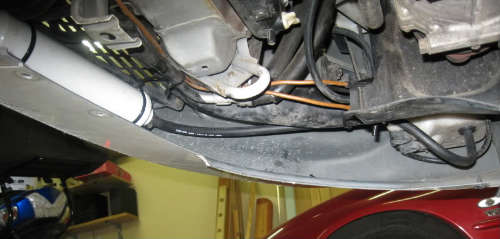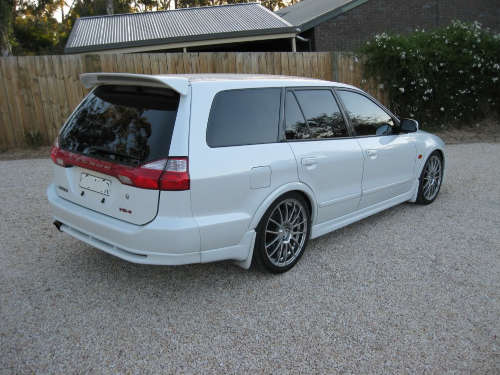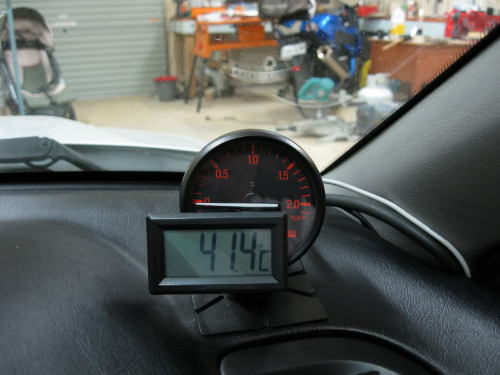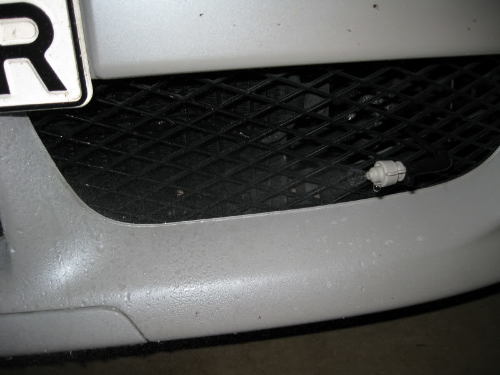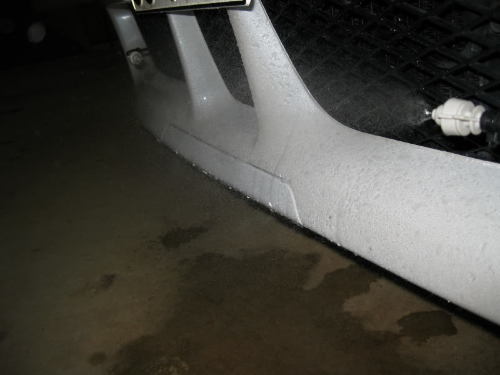eddyvr4
Leaving Skid Marks
Setting up a DIY water injection system and an integrated intercooler water spray for a VR4 Legnum.
This Article details my adventure into the somewhat uncharted world of Water Injecting a Legnum, with some Intercooler water spraying thrown in for good measure. Having spent too much on the car already, the concept of adding water to make the car go harder was appealing, It had an environmentally conscious ring to it, sounded cheap, and I had a spare rainwater tankful at home that I thought could be put to good use.
For the ignorant reader, i start with a brief summary of Water Injection and IC Water Spraying. Ill qualify this to say I have no qualifications in this field, its just my layperson understanding. But I like the watered down theory of it, so here goes:
Water injection 101
What is water injection? (abbreviated now to WI)
Water injection involves spraying water (often water/methanol) INTO the intake tract, to be ingested by the engine along with petrol and air.
Why would I inject water?
Principally, to supress detonation, or raise the point at which detonation occurs, allowing an engine to be tuned more aggressively than without WI, or to provide a greater margin of safety from detonation than without WI.
How does adding water create more power?
It doesn’t, but … ..Water absorbs 6 x the amount of heat than the equivalent volume of fuel. So, instead of running an engine rich to keep temps down, and suffering a resultant loss of power as a side effect (because excessive, unburnt hydrocarbons hinder the combustion process), instead take out all the extra 'cooling' fuel, add 1/6 the amount of water to achieve the same cooling effect, and improved combustion to boot. Add a bit more water and improve cooling even more than with the original rich mixture. At this point there may still be spare room left over in the combustion chamber (after pulling the extra fuel and adding relatively less water), so we can add more air and fuel now to fill that spare space, and hence make more power than previously. Its often said WI has a similar effect to running higher octane fuel - its not that the water 'adds power', but its cooling effect allows you to tune the car harder as if you were running a higher octane fuel than what is actually in the tank. Also it follows at the same tune you can improve your fuel economy, although that was not my concern. Anyway i bought the theory above, although unfortunately i could not convince my tuner of the same, but im getting ahead of myself ..
Water must be injected through a misting nozzle at high pressure to 'atomise' the water - or mist it up very finely. If the bits of water arent really small, they wont absorb much heat, or find their way evenly into each cylinder. 110 - 140psi injection is common, 50psi is probably about the min you would go for. (By comparison fuel pressure is usually 43 to 44psi)
Is a external water sprayer for my intercooler, "water injection"?
Glad you asked, but no it is not. An intercooler "watersprayer" is a great idea, its purpose is to improve the peformance of the intercooler. Reducing intake temps via an intercooler can help raise the point at which an engine starts to knock as well, but if detonation is occuring when intake temps are low, a bigger intercooler or intercooler water spray wont help much.
What are the downsides of WI? Like many mods, theres a few...
Relative complexity of install and operation - pumps, water, wiring, measuring and tuning the system. This, in my opinion, is why you don’t see much of it.
It can be difficult depending on inlet manifold design etc to get even water distribution to all cylinders, and this can greatly impact the effectiveness of WI on certain engines, without going for custom manifold and individual port injection etc - expensive..
Potential for engine damage from detonation if WI fails, requiring extra complexity of safeguards to detect/prevent this. (more later)
Having to top up water.
Now, there are plenty of ifs and buts, but that’s my simplistic understanding and all that’s warranted here.
InterCooler Water Spraying 101
An intercooler water sprayer is the application of a mist of water (under certain conditions (usually under high boost, or when IC temp is high) )on the OUTSIDE of the intercooler to improve its efficiency. Water is sprayed onto the intercooler. As it evaporates, it draws the heat out of the intercooler, cooling it down. The cooler the intercooler core is, the better it works! Generally sprayers are triggered based on boost level, or IC core temp or a combination of both. (Autospeed have a great kit/writeup for an intelligent controlller) Theoretically, with the effect of evaporation, an IC sprayer you can bring the IC core to BELOW ambient temperature, which would be impossible with just a bigger intercooler. A smaller IC with a water spray may be able to outpeform a larger IC core thermally, and also maintain a crisp throttle response that a small IC benefits from. It really doesn’t need more explanation than that.
Disadvantages? Plenty - complexity of pump sprayer/s controlling electronics, having to store and top up water. compared to just bolting in a bigger core with no subsequent maintenance, or risk of problem/failure.
Why try WI on a Legnum?
That’s a very good question:.
-On the dyno, the tuner told me detonation in the midrange was limiting how much advance we could add via the Haltech piggyback and hence how much midrange power we could get. And my intake temps were not that really high. (approx 50 deg peak on dyno runs (pretty cold day mind you)). WI directly targets the detonation problem. I was not convinced a bigger intercooler would help much with the detonation, because my intake temps werent sky high.
-It’s a fairly cheap experiment $ wise.
-Im resisting a bigger intercooler as I don’t want to compromise my throttle response, but im also yet to see proof (hard data) the stock cooler is a limiting factor at my (moderate) power output.
I thought it would be interesting to see what can (or cant) be achieved with WI on a Legnum!.
The car is in a fairly mildly and typically modded state, so my results should be appliccable to a fairly wide audience, whether they be positive or negative. If nothing else, others can learn from my experience….
My relevant (power related) mods are : RPW dumps, full 3inch exhaust (hiflow cat), walbro fuel pump, Haltech interceptor. Manual boost bleed valve. Everything else is stock. (intercooler/airbox/air filter/piping/BOV etc) My dyno chart (which means bugger all for comparison unless you ran your car on this exact dyno) was as below: I include it because graphs look professional, especially to those in management type jobs.
Why try an IC water sprayer on a Legnum?
It does complicate things, but, with the water injection, most of the hardware was there already, all I needed to do was add some extra plumbing and nozzles onto the WI system and I also had an intercooler spray. It only added about $40 to the cost of the system!
I had a theory that I could achieve good results with a water spray on the OEM intercooler, rather than putting in a bigger intercooler. The stock IC is a tube and fin design which in theory flow well, so just increasing its thermal capacity may be all I needed. The problem also with a bigger intercooler is the resultant increase in intake tract volume results in worse throttle response. (how much worse is arguable, but the physics is not.).
My Legnum specific Water Injection design.
Firstly, Where to inject the water? (pre or post turbo/intercooler, multiple points etc)
There are very lengthy debates on this, but the most widely accepted view I could find was: inject water immediately after the intercooler. Why? The greater the temp differential across the intercooler, the more effective it will be. So let the intercooler do it's job as efficiently as possible, THEN add water. Also there is some debate about water droplets damaging turbo impellers and airflow sensors etc, so post intercooler avoids this potential problem altogether. The possible drawback here is theres less tract distance for the water to mix with the air… But whichever way you go, theres always 'some' issue, so that was my decision.
Heres a pic, the nozzle itself does not protrude into to intercooler tube at all, and its on the outside radius of the tube, allowing the (cone) spray more area to be collected by the airflow before it hits a surface. Also the nozzle is easily unthreaded and removed for flow testing/ cleaning etc, and the threaded hole can easily be plugged with a bolt if required. We tapped a M12 thread onto the brass nozzle ourselves.
Now, How much water do you inject for a Legnum?
To determine the required flow, the general rule for a street vehicle is you inject at least 10 -15% of the fuel volume, based on the peak power you expect the car to run. Then you tune WI from there. So for the Legnum, I took a very simplistic view, and figured if I was running all six (390cc) injectors at 100% duty cycle, then 2340cc/min is the peak fuel I can flow. So 10% of this is 234cc, (or 234 millilitres of water per minute) so I need a WI system that can deliver around this amount.
As its very difficult to calculate the flow of a DIY setup, so you guesstimate the parts (based on dubious Internet threads like this one) then bench test the connected bits to see what actually does. Sounds complicated, but its not. To measure the flow you simply run the pump off a car Battery with hose drawing from a bucket of water and point the nozzle into a separate container for exactly 1 minute, then weigh the nett water captured, 200grams = 200ccs of water etc etc. If you can do this on a bench, and not on the floor, then you have officially bench tested it. Then when it doesn’t deliver what you expected you order more pricey nozzle tips, poke, prod, spill, test, improvise, hurl spanner at wall, retest, cut, stuff, twist, strip thread, damage paintwork, break a special plastic clip and so on till it eventually succumbs to a simple combination of patience and blind rage. I eventually got to 200cc and called that close enough, preferring to be a little on the low side than too much.
Yep, I had no end of trouble trying to get everything to work properly. I could carry on for hours to cover all the problems, but I wont. In hindsight, my advice would be to buy an off the shelf kit, unless you have a lot of patience fiddling. Before you go rushing off with my uncopyrighted blueprints, note my 'as built' design is compromised, as I was stubbornly trying to keep a tight lid on costs, especially as this is really an experiment with no guarantee of a positive outcome. I had to bypass the pressure limiting switch on the pump otherwise the pump would 'bounce' on and off the pressure switch when spraying (causing an uneven pulse of water, because the tiny nozzle size meant the pump built up too much pressure, too quickly…. Using an 'accumulator' (like a large water hammer arrestor) to store water under pressure ready for injection, would sort this out. The injection signal simply drives the pump flat out, (pump pressure switch bypassed) which is pretty crude. Also, the solenoid I had kicking around (from an old boost controller project that never happened) is not ideal for the job, over 65psi and it intermittently jams, (so I had to put it on the low pressure side of the pump, instead of the high side). The only purpose of the solenoid in my setup is to stop engine vacuum drawing water into the engine when its off boost, and as a safeguard if the pump leaks.
The second big problem I had, was way too much water coming out the intercooler sprayers, and unlike the brass WI bits, the cheap fittings and vacuum hose (pushed over 4mm annealed copper tubing) couldn’t take the pressure. (I couldn’t find hoseclamps small enough) After much headscratching, a plastic restrictor pill inside the water line, (cut the end off a plastic chopstick!) with a tiny, 0.65mm hole in it , brought the pressure and volume of water down to a good amount.
I guess the pump pressure to be around 90 - 100psi, So my actual injection pressure under boost would theoretically be 100psi-16psi = 84psi. All these figures are guesstimated or measured crudely, the idea was simply to check my numbers were in the ballpark with accepted benchmarks, and didn’t vary wildly when the environment changed a bit, which looked to be the case. Lets not forget this is a backyard job after all, and weve got to leave the door open for catastrophic failures, (preferably including a very loud bang or some smoke), otherwise the fun is taken out of it. i swapped the solenoid and pump location from below pic, but it shows how the whole thing just bolts in on the plate.
Ok, When do you inject the water?
Basically, inject water around peak torque when the engine load is high. Many systems simply turn on a fixed amount of water spray above a certain boost level ie 6 or 10 psi etc, with a boost switch. (even some expensive ones) As I already run a Haltech interceptor, my plan is to use the extra injector output to control the WI , which gives me the ability to be more selective in the load area where we can inject the water than a simple boost switch. (and maybe even play with duty cycle a bit) But im not sure the outcome would be much better or different, its just I had the haltech there so might as well use it.
The solenoid (on/off water switch) in between the pump and the nozzle stops water leakage under vacuum, and it allows the pump to 'prime' in the background and so the full water pressure is instantly available to the nozzle when the solenoid is pulsed open. On its own, the pump takes a little bit of time to come up to pressure, only fractions of a second, but I believe the solenoid will allow finer and more consistent control and results than powering the pump up and down, which will be more 'laggy'. (apply the same thinking to the fuel system, you don’t pump direct to the cylinder head, you pump to the injector, then fine tune the delivery there...)
In the Legnum, I mounted all the hardware on an aluminium plate under the passenger wheel arch, using existing (unused) factory threaded nuts. no peramnaent alterations were required, and the whole install is basically invisible from under the bonnet, and easily removed. I ran a single 7 core trailer plug cable back into the car for all the power/control so there is a single extra visible balack cable in the engine bay, which is hard to notice. (the tap had to be removed as it couldnt hack the pressure - i wanted this there so i could easily isolate the IC water spray to see what the WI did on its own, but now i just had to run it all together)
My Legnum specific Intercooler water sprayer design.
I used annealed copper tube, vacuum hose, some agriculural misting nozzles (5L per hr i think they were) and plumbed it back to the water injection, see pics. the good thing about the copper tube, is you can bend it to shape then it just stays there, no need for unsightly brackets
The electrics:
The electrics costed more in fuel to cover the repeated trips to Jaycar for 'one more bit' than the actual components themselves. (and that’s travelling on the motorbike too). Heres a circuit diagram, my own design. The haltech digital outputs switch to ground, and ive used a solid state relay to allow for fast switching the solenoid. (as opposed to a mechanical relay) There is an Isolate switch so the pump can be isolated in case it ever gets stuck on for some reason. Secondly there is a manual/auto/off rocker, In 'auto', the haltech controls the solenoid, in manual, the solenoid is turned on for manual operation and 'off', for well.. Turning it Off. The light shows when the system is being triggered. I started with a more sophisticated setup, but pared it back to this to circumvent some problems.
How often will the water need filling?
The Legnum factory washer bottle holds about 4.5litres, with the WI sprayer running at about 200cc and the IC sprayers about 100cc each, (total 400cc) so i should have about 11 minutes of continuous operation (ie high load/boost) before emptying the bottle, prob ok though not great.
I was able to very easily plumb the hose to the washer bottle simply by drilling, fitting a fat rubber grommet and forcing the pipe in, the hose spreads the grommet and its watertight. It’s a simple 'interference fit' No removal of washer bottle required, which avoided a huge amount of swearing and spanner throwing. The filter is loomstrapped as shown. The filter will avoid nozzle blockages and requires no maintenance. I could have mounted the filter to the same aluminium plate the rest of the hardware, but this way the system should prime more reliably as the water basically flow across and down to the pump by gravity (the pump does 'self prime', but its a very half hearted 'i was made in china' kind of prime…)
What if the water does run out?
Will I damage the engine? Will it knock badly at full boost if the water stops? When on the dyno, we found my ECU very, very sensitive to knock, and it very quickly and agressively retarded the timing when knock occurred. So my view is that running out of water is to be avoided, but should not result in engine damage as the factory ECU knock detection will step in and arrest the timing if this occurs. My main concern is that the water wont be distributed evenly, knock will occur only in some cylinders, too far away form the knock detector, and ill ruin the engine this way. But the knock sensor is fairly central… Needless to say this is my main concern, but hopefully we can test during the tuning stage.. On the dyno, Tune, disable WI and see what happens..
Costs
kits seem to cost around $600 upwards + installation (google search on "aquamist")
I took the more stupid - no, "rewarding" and path of sourcing my own bits and pieces as follows:
Sprayer nozzle (Autospeed sourced 'spraying systems' brass nozzle/filter $50
Pump - 2.1L min 55psi 1.8 amp general purpose campervan type pump. (Pressure is actually adjustable upwards of this) $45 off ebay new - a bargain!
Hose - fuel hose 3m $15
Brass fittings $30
Aluminium plate to mount all hardware $20
Custom mounting of sprayer to intercooler cold side pipe $30
5m of 7 core trailer plug cable $20
Switches, misc and solid state relay (jaycar) $45
Hose clamps $8 rubber grommet
Goyen solenoid $0 was kicking around from an old boost control project) - $0
Water filter (to prevent nozzle clogging) $30 (ebay)
=$293
If I was to add up the time stuffing around measuring this and sizing up that and dropping in here and there…explaining the benefits to my 4 yr old daughter etc.. it is ridiculous, but the upside is ive burnt countless months on and off prodding and poking around in the garage, instead of actually driving the car, so the savings in fuel, tyres and traffic infringement notices has actually put me ahead in my bank balance, so in fact this project has made me money. This can be your business case to the missus as well...
So the next installment will cover some results, frustrations & learnings,
to be continued.......
This Article details my adventure into the somewhat uncharted world of Water Injecting a Legnum, with some Intercooler water spraying thrown in for good measure. Having spent too much on the car already, the concept of adding water to make the car go harder was appealing, It had an environmentally conscious ring to it, sounded cheap, and I had a spare rainwater tankful at home that I thought could be put to good use.
For the ignorant reader, i start with a brief summary of Water Injection and IC Water Spraying. Ill qualify this to say I have no qualifications in this field, its just my layperson understanding. But I like the watered down theory of it, so here goes:
Water injection 101
What is water injection? (abbreviated now to WI)
Water injection involves spraying water (often water/methanol) INTO the intake tract, to be ingested by the engine along with petrol and air.
Why would I inject water?
Principally, to supress detonation, or raise the point at which detonation occurs, allowing an engine to be tuned more aggressively than without WI, or to provide a greater margin of safety from detonation than without WI.
How does adding water create more power?
It doesn’t, but … ..Water absorbs 6 x the amount of heat than the equivalent volume of fuel. So, instead of running an engine rich to keep temps down, and suffering a resultant loss of power as a side effect (because excessive, unburnt hydrocarbons hinder the combustion process), instead take out all the extra 'cooling' fuel, add 1/6 the amount of water to achieve the same cooling effect, and improved combustion to boot. Add a bit more water and improve cooling even more than with the original rich mixture. At this point there may still be spare room left over in the combustion chamber (after pulling the extra fuel and adding relatively less water), so we can add more air and fuel now to fill that spare space, and hence make more power than previously. Its often said WI has a similar effect to running higher octane fuel - its not that the water 'adds power', but its cooling effect allows you to tune the car harder as if you were running a higher octane fuel than what is actually in the tank. Also it follows at the same tune you can improve your fuel economy, although that was not my concern. Anyway i bought the theory above, although unfortunately i could not convince my tuner of the same, but im getting ahead of myself ..
Water must be injected through a misting nozzle at high pressure to 'atomise' the water - or mist it up very finely. If the bits of water arent really small, they wont absorb much heat, or find their way evenly into each cylinder. 110 - 140psi injection is common, 50psi is probably about the min you would go for. (By comparison fuel pressure is usually 43 to 44psi)
Is a external water sprayer for my intercooler, "water injection"?
Glad you asked, but no it is not. An intercooler "watersprayer" is a great idea, its purpose is to improve the peformance of the intercooler. Reducing intake temps via an intercooler can help raise the point at which an engine starts to knock as well, but if detonation is occuring when intake temps are low, a bigger intercooler or intercooler water spray wont help much.
What are the downsides of WI? Like many mods, theres a few...
Relative complexity of install and operation - pumps, water, wiring, measuring and tuning the system. This, in my opinion, is why you don’t see much of it.
It can be difficult depending on inlet manifold design etc to get even water distribution to all cylinders, and this can greatly impact the effectiveness of WI on certain engines, without going for custom manifold and individual port injection etc - expensive..
Potential for engine damage from detonation if WI fails, requiring extra complexity of safeguards to detect/prevent this. (more later)
Having to top up water.
Now, there are plenty of ifs and buts, but that’s my simplistic understanding and all that’s warranted here.
InterCooler Water Spraying 101
An intercooler water sprayer is the application of a mist of water (under certain conditions (usually under high boost, or when IC temp is high) )on the OUTSIDE of the intercooler to improve its efficiency. Water is sprayed onto the intercooler. As it evaporates, it draws the heat out of the intercooler, cooling it down. The cooler the intercooler core is, the better it works! Generally sprayers are triggered based on boost level, or IC core temp or a combination of both. (Autospeed have a great kit/writeup for an intelligent controlller) Theoretically, with the effect of evaporation, an IC sprayer you can bring the IC core to BELOW ambient temperature, which would be impossible with just a bigger intercooler. A smaller IC with a water spray may be able to outpeform a larger IC core thermally, and also maintain a crisp throttle response that a small IC benefits from. It really doesn’t need more explanation than that.
Disadvantages? Plenty - complexity of pump sprayer/s controlling electronics, having to store and top up water. compared to just bolting in a bigger core with no subsequent maintenance, or risk of problem/failure.
Why try WI on a Legnum?
That’s a very good question:.
-On the dyno, the tuner told me detonation in the midrange was limiting how much advance we could add via the Haltech piggyback and hence how much midrange power we could get. And my intake temps were not that really high. (approx 50 deg peak on dyno runs (pretty cold day mind you)). WI directly targets the detonation problem. I was not convinced a bigger intercooler would help much with the detonation, because my intake temps werent sky high.
-It’s a fairly cheap experiment $ wise.
-Im resisting a bigger intercooler as I don’t want to compromise my throttle response, but im also yet to see proof (hard data) the stock cooler is a limiting factor at my (moderate) power output.
I thought it would be interesting to see what can (or cant) be achieved with WI on a Legnum!.
The car is in a fairly mildly and typically modded state, so my results should be appliccable to a fairly wide audience, whether they be positive or negative. If nothing else, others can learn from my experience….
My relevant (power related) mods are : RPW dumps, full 3inch exhaust (hiflow cat), walbro fuel pump, Haltech interceptor. Manual boost bleed valve. Everything else is stock. (intercooler/airbox/air filter/piping/BOV etc) My dyno chart (which means bugger all for comparison unless you ran your car on this exact dyno) was as below: I include it because graphs look professional, especially to those in management type jobs.
Why try an IC water sprayer on a Legnum?
It does complicate things, but, with the water injection, most of the hardware was there already, all I needed to do was add some extra plumbing and nozzles onto the WI system and I also had an intercooler spray. It only added about $40 to the cost of the system!
I had a theory that I could achieve good results with a water spray on the OEM intercooler, rather than putting in a bigger intercooler. The stock IC is a tube and fin design which in theory flow well, so just increasing its thermal capacity may be all I needed. The problem also with a bigger intercooler is the resultant increase in intake tract volume results in worse throttle response. (how much worse is arguable, but the physics is not.).
My Legnum specific Water Injection design.
Firstly, Where to inject the water? (pre or post turbo/intercooler, multiple points etc)
There are very lengthy debates on this, but the most widely accepted view I could find was: inject water immediately after the intercooler. Why? The greater the temp differential across the intercooler, the more effective it will be. So let the intercooler do it's job as efficiently as possible, THEN add water. Also there is some debate about water droplets damaging turbo impellers and airflow sensors etc, so post intercooler avoids this potential problem altogether. The possible drawback here is theres less tract distance for the water to mix with the air… But whichever way you go, theres always 'some' issue, so that was my decision.
Heres a pic, the nozzle itself does not protrude into to intercooler tube at all, and its on the outside radius of the tube, allowing the (cone) spray more area to be collected by the airflow before it hits a surface. Also the nozzle is easily unthreaded and removed for flow testing/ cleaning etc, and the threaded hole can easily be plugged with a bolt if required. We tapped a M12 thread onto the brass nozzle ourselves.
Now, How much water do you inject for a Legnum?
To determine the required flow, the general rule for a street vehicle is you inject at least 10 -15% of the fuel volume, based on the peak power you expect the car to run. Then you tune WI from there. So for the Legnum, I took a very simplistic view, and figured if I was running all six (390cc) injectors at 100% duty cycle, then 2340cc/min is the peak fuel I can flow. So 10% of this is 234cc, (or 234 millilitres of water per minute) so I need a WI system that can deliver around this amount.
As its very difficult to calculate the flow of a DIY setup, so you guesstimate the parts (based on dubious Internet threads like this one) then bench test the connected bits to see what actually does. Sounds complicated, but its not. To measure the flow you simply run the pump off a car Battery with hose drawing from a bucket of water and point the nozzle into a separate container for exactly 1 minute, then weigh the nett water captured, 200grams = 200ccs of water etc etc. If you can do this on a bench, and not on the floor, then you have officially bench tested it. Then when it doesn’t deliver what you expected you order more pricey nozzle tips, poke, prod, spill, test, improvise, hurl spanner at wall, retest, cut, stuff, twist, strip thread, damage paintwork, break a special plastic clip and so on till it eventually succumbs to a simple combination of patience and blind rage. I eventually got to 200cc and called that close enough, preferring to be a little on the low side than too much.
Yep, I had no end of trouble trying to get everything to work properly. I could carry on for hours to cover all the problems, but I wont. In hindsight, my advice would be to buy an off the shelf kit, unless you have a lot of patience fiddling. Before you go rushing off with my uncopyrighted blueprints, note my 'as built' design is compromised, as I was stubbornly trying to keep a tight lid on costs, especially as this is really an experiment with no guarantee of a positive outcome. I had to bypass the pressure limiting switch on the pump otherwise the pump would 'bounce' on and off the pressure switch when spraying (causing an uneven pulse of water, because the tiny nozzle size meant the pump built up too much pressure, too quickly…. Using an 'accumulator' (like a large water hammer arrestor) to store water under pressure ready for injection, would sort this out. The injection signal simply drives the pump flat out, (pump pressure switch bypassed) which is pretty crude. Also, the solenoid I had kicking around (from an old boost controller project that never happened) is not ideal for the job, over 65psi and it intermittently jams, (so I had to put it on the low pressure side of the pump, instead of the high side). The only purpose of the solenoid in my setup is to stop engine vacuum drawing water into the engine when its off boost, and as a safeguard if the pump leaks.
The second big problem I had, was way too much water coming out the intercooler sprayers, and unlike the brass WI bits, the cheap fittings and vacuum hose (pushed over 4mm annealed copper tubing) couldn’t take the pressure. (I couldn’t find hoseclamps small enough) After much headscratching, a plastic restrictor pill inside the water line, (cut the end off a plastic chopstick!) with a tiny, 0.65mm hole in it , brought the pressure and volume of water down to a good amount.
I guess the pump pressure to be around 90 - 100psi, So my actual injection pressure under boost would theoretically be 100psi-16psi = 84psi. All these figures are guesstimated or measured crudely, the idea was simply to check my numbers were in the ballpark with accepted benchmarks, and didn’t vary wildly when the environment changed a bit, which looked to be the case. Lets not forget this is a backyard job after all, and weve got to leave the door open for catastrophic failures, (preferably including a very loud bang or some smoke), otherwise the fun is taken out of it. i swapped the solenoid and pump location from below pic, but it shows how the whole thing just bolts in on the plate.
Ok, When do you inject the water?
Basically, inject water around peak torque when the engine load is high. Many systems simply turn on a fixed amount of water spray above a certain boost level ie 6 or 10 psi etc, with a boost switch. (even some expensive ones) As I already run a Haltech interceptor, my plan is to use the extra injector output to control the WI , which gives me the ability to be more selective in the load area where we can inject the water than a simple boost switch. (and maybe even play with duty cycle a bit) But im not sure the outcome would be much better or different, its just I had the haltech there so might as well use it.
The solenoid (on/off water switch) in between the pump and the nozzle stops water leakage under vacuum, and it allows the pump to 'prime' in the background and so the full water pressure is instantly available to the nozzle when the solenoid is pulsed open. On its own, the pump takes a little bit of time to come up to pressure, only fractions of a second, but I believe the solenoid will allow finer and more consistent control and results than powering the pump up and down, which will be more 'laggy'. (apply the same thinking to the fuel system, you don’t pump direct to the cylinder head, you pump to the injector, then fine tune the delivery there...)
In the Legnum, I mounted all the hardware on an aluminium plate under the passenger wheel arch, using existing (unused) factory threaded nuts. no peramnaent alterations were required, and the whole install is basically invisible from under the bonnet, and easily removed. I ran a single 7 core trailer plug cable back into the car for all the power/control so there is a single extra visible balack cable in the engine bay, which is hard to notice. (the tap had to be removed as it couldnt hack the pressure - i wanted this there so i could easily isolate the IC water spray to see what the WI did on its own, but now i just had to run it all together)
My Legnum specific Intercooler water sprayer design.
I used annealed copper tube, vacuum hose, some agriculural misting nozzles (5L per hr i think they were) and plumbed it back to the water injection, see pics. the good thing about the copper tube, is you can bend it to shape then it just stays there, no need for unsightly brackets
The electrics:
The electrics costed more in fuel to cover the repeated trips to Jaycar for 'one more bit' than the actual components themselves. (and that’s travelling on the motorbike too). Heres a circuit diagram, my own design. The haltech digital outputs switch to ground, and ive used a solid state relay to allow for fast switching the solenoid. (as opposed to a mechanical relay) There is an Isolate switch so the pump can be isolated in case it ever gets stuck on for some reason. Secondly there is a manual/auto/off rocker, In 'auto', the haltech controls the solenoid, in manual, the solenoid is turned on for manual operation and 'off', for well.. Turning it Off. The light shows when the system is being triggered. I started with a more sophisticated setup, but pared it back to this to circumvent some problems.
How often will the water need filling?
The Legnum factory washer bottle holds about 4.5litres, with the WI sprayer running at about 200cc and the IC sprayers about 100cc each, (total 400cc) so i should have about 11 minutes of continuous operation (ie high load/boost) before emptying the bottle, prob ok though not great.
I was able to very easily plumb the hose to the washer bottle simply by drilling, fitting a fat rubber grommet and forcing the pipe in, the hose spreads the grommet and its watertight. It’s a simple 'interference fit' No removal of washer bottle required, which avoided a huge amount of swearing and spanner throwing. The filter is loomstrapped as shown. The filter will avoid nozzle blockages and requires no maintenance. I could have mounted the filter to the same aluminium plate the rest of the hardware, but this way the system should prime more reliably as the water basically flow across and down to the pump by gravity (the pump does 'self prime', but its a very half hearted 'i was made in china' kind of prime…)
What if the water does run out?
Will I damage the engine? Will it knock badly at full boost if the water stops? When on the dyno, we found my ECU very, very sensitive to knock, and it very quickly and agressively retarded the timing when knock occurred. So my view is that running out of water is to be avoided, but should not result in engine damage as the factory ECU knock detection will step in and arrest the timing if this occurs. My main concern is that the water wont be distributed evenly, knock will occur only in some cylinders, too far away form the knock detector, and ill ruin the engine this way. But the knock sensor is fairly central… Needless to say this is my main concern, but hopefully we can test during the tuning stage.. On the dyno, Tune, disable WI and see what happens..
Costs
kits seem to cost around $600 upwards + installation (google search on "aquamist")
I took the more stupid - no, "rewarding" and path of sourcing my own bits and pieces as follows:
Sprayer nozzle (Autospeed sourced 'spraying systems' brass nozzle/filter $50
Pump - 2.1L min 55psi 1.8 amp general purpose campervan type pump. (Pressure is actually adjustable upwards of this) $45 off ebay new - a bargain!
Hose - fuel hose 3m $15
Brass fittings $30
Aluminium plate to mount all hardware $20
Custom mounting of sprayer to intercooler cold side pipe $30
5m of 7 core trailer plug cable $20
Switches, misc and solid state relay (jaycar) $45
Hose clamps $8 rubber grommet
Goyen solenoid $0 was kicking around from an old boost control project) - $0
Water filter (to prevent nozzle clogging) $30 (ebay)
=$293
If I was to add up the time stuffing around measuring this and sizing up that and dropping in here and there…explaining the benefits to my 4 yr old daughter etc.. it is ridiculous, but the upside is ive burnt countless months on and off prodding and poking around in the garage, instead of actually driving the car, so the savings in fuel, tyres and traffic infringement notices has actually put me ahead in my bank balance, so in fact this project has made me money. This can be your business case to the missus as well...
So the next installment will cover some results, frustrations & learnings,
to be continued.......

